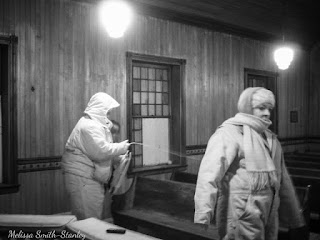Within the walls of these old homes are lingering memories of a time long gone but perhaps not too far forgotten. If those walls could talk, what would they tell us? They might tell of happy times with family, watching growing children, laughter and joy. They also may keep deep secrets, hide lingering sadness, and mourning for their losses. An old house is not just a place made of wood and bricks, it's a big box full of emotions and remembrance. I think sometimes the house may hold on to some of these feelings long after their inhabitants have moved on.
Over the years as the old house ages, the old memories begin to slowly fade away just as she does. Left forgotten and forlorn, slowly, nature begins to reclaim what was once hers. Exposed to the elements, with aging bones, she begins to break down. Her roof weakens and begins to leak, the foundation may begin to show cracks. The doors and windows warp with the changes in the weather and over time, the vines begin to cover her up face as she is entering her final years, months, days. At some point, she eventually begins to crumble completely, or her fate is determined for her, and she is torn to the ground.
When she was built, she was likely hand made with delicate care and intricate detail. Her wood may have been cut from the lot where she stood, or her old bricks may have been made from the mud she sat upon. The smallest details from hinges on her doors to her beautiful winding staircase would showcase the fine craftsmanship of her time. But left to decay, she is no longer needed, no longer appreciated or no longer has someone to care for and love her.
I stumble upon many beautiful old houses when I am in search of abandoned places and I spend many hours just driving the backroads seeking out the next amazing place. I have found many along the way, but only a few have really captured my heart. I travel back to visit them from time to time, through the changing seasons and even over the years, I have watched time and mother nature take their toll. I have been heartbroken though, as I have seen too many of these old beauties torn down. It hurts to see such a wonderful piece of history come crashing down, especially by a bulldozer.
I love these old homes, I have hopes to see them be restored, loved again and put to good use. I wish in some small way that I can save them all, but I know that is only a dream. Reality hits when I go once again to visit, and she is no longer there, and the only thing that is left is the empty space where she once stood tall and proud. I am, however, very thankful for the opportunities to take photographs of these places, because in the end, memories are all we will have.
Photos above - Top - House on the verge of collapse in Cabell County, WV. Middle - Recently torn down 1830s home in Mason County, WV. Bottom - Recently torn down 1800s home in Mason County, WV. All photos on this site are property of the author, Melissa Stanley, unless otherwise noted. Photos should only be used with permission of the author/photographer.






















